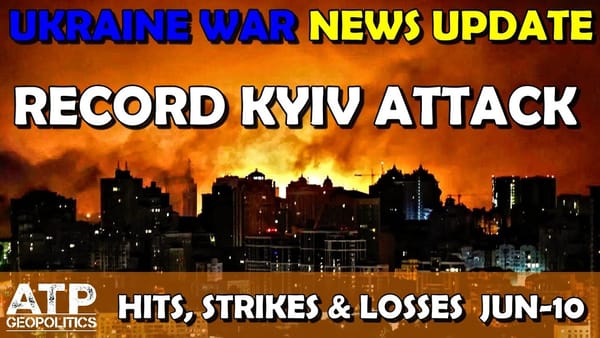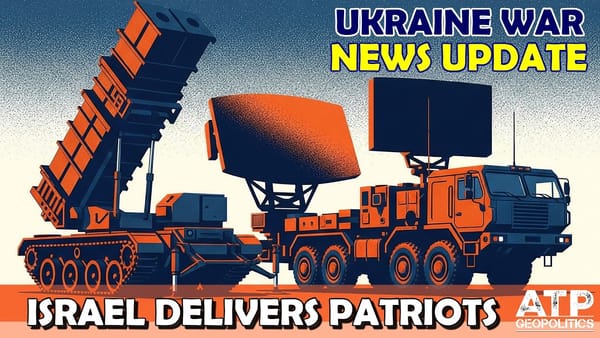Ukraine War Update NEWS: Pt 1 - Overnight & Other News
Table of Contents 📖
"Spray down your returning POWs at a cold, depressing airport. Load them onto buses like cattle. And, yeah, probably tell them they have two days before being remobilized."
Hello Team
🎦 00:00-00:20⏩
Jonathan welcomes viewers to another ATP Geopolitics update on the Ukraine war, kicking off the first part of the 2nd February 2024 news. He mentions that he is still feeling a little under the weather but is going to persevere with the update.
Return to top⤴️
🪦 DISCLAIMER FOR GENERAL STAFF LOSSES DATA
- These are real people with real lives and real families who love them. Don’t let the numbers sap your humanity.
- These numbers probably aren’t accurate but they’re the best we have and we don’t need them to be accurate to be indicative of patterns of activity.
- All losses are estimates. Losses cannot be counted with accuracy because of the conditions on the ground.
- Both sides would see it to be of their advantage to minimize their own losses maximize the other side’s losses.
- Neither side releases their losses but we have enough transparency from the Ukrainian side to have confidence in they are indicative.
- Personnel losses are hard to count. If a soldier gets injured, heals up, and returns to the front line only to get injured again, is that one loss or two? Also, how to deal with losses from PMC’s or soldiers fighting with RF from occupied territories?
- Equipment losses are hard to count. If an AA complex involves several parts and one part gets disabled, is that a loss, or a fraction of a loss? If a tank gets disabled, repaired, back into the fight, then disabled again, is that one lost tank or two?
- All recorded losses are vulnerable to multiple reporting. We have already seen numerous cases of multiple drones in the air reporting the same loss from different angles as multiple engagements.
- Losses are not always reported on the same day they occurred. It is frequent that drone losses are reported at least 24 hours after other terrestrial equipment losses. Certain losses may not be reported for days or weeks for military intelligence reasons.
Ukrainian General Staff Daily Losses - 01/02/2024
🎦 00:20-02:05⏩
Jonathan delves into the Ukrainian General Staff's reported Russian losses for the previous day, including:
- 830 personnel.
- 9 tanks.
- 19 armoured personnel vehicles (APVs)
- 46 artillery systems.
He questions the accuracy of such a high number of artillery system losses but acknowledges that if accurate, it doesn't seem to have impacted the intensity of Russian shelling in some frontline areas. Jonathan also highlights the significance of the reported loss of 49 Russian vehicles and fuel tanks.
Return to top⤴️
Oryx Daily Losses 01/02/2024
🎦 02:05-05:00⏩
Referencing Andrew Perpetua's 'Oryx' visually confirmed loss statistics, Jonathan points out that the data aligns with the General Staff figures. He notes:
- Russian losses are four to five times higher than Ukrainian losses for the past 24 hours.
- Ukrainian losses are comparatively low-level, consisting mainly of surveillance equipment, a couple of T-64BV tanks, and a few Lancet drone hits.
- Conversely, Russian losses are substantial and diverse, spanning electronic warfare systems, a drone suppression system, a variety of tanks (T-80s, T-72s, T-62s, and even a T-90), infantry fighting vehicles, APCs, trucks, and civilian vehicles.
- Jonathan observes that this volume of sustained equipment loss will significantly hinder any chance of a Russian victory.
Russian Warship Sunk by Drones
🎦 05:00-14:05⏩
This segment centres on the confirmed sinking of a Russian Project 1241.1 'Even' Ivanovets class warship. Jonathan provides context to his breaking news report from the previous day:
- The incident involved an estimated 40 Russian sailors on board.
- Jonathan acknowledges previous discussions about the potential for low-cost drones to sink large naval vessels.
- He cites an anecdote about his 13-year-old son's astute observation about the vulnerability of warships to coordinated drone attacks.
- Jonathan speculates that this incident represents a pivotal moment in military history, demonstrating a paradigm shift in naval warfare.
- He praises the Ukrainian drone tactics, highlighting the strategic targeting of the ship's stern (affecting steering and propulsion) and subsequent attacks on previously damaged areas.
- Jonathan touches on Russian disinformation efforts to downplay the significance of the event. He mentions a tweet from pro-Russian commentator 'Squatsons Aiden' attempting to dismiss the ship as a 35-year-old vessel with minimal impact on the war.
- He emphasises the significance of the loss for Russia, both in terms of military capability and public perception.
- Jonathan estimates that over 20% of the Black Sea Fleet has been destroyed, forcing the remaining ships to seek refuge in Novorossiysk.
- Reports, though unconfirmed, suggest that two additional Russian warships were possibly attacked within the last 48 hours, potentially indicating a sustained Ukrainian offensive using naval drones.
- Jonathan reveals that Ukraine's spy boss, Lieutenant General Budanov, claimed six Magura V5C drones were used in the attack.
- The summary includes an image of the Magura V5C drone for viewers to reference.
Belbeck Air Base Attack: Update
🎦 14:05-15:21⏩
Jonathan circles back to the earlier reports about a Ukrainian missile strike on Belbeck Air Base in Crimea:
- Initial claims suggested multiple casualties (potentially up to 20) and the destruction of three Russian jets.
- While acknowledging the initial skepticism surrounding the claims, Jonathan highlights a developing story about the death of a high-ranking Russian officer:
- Lieutenant General Alexander Tatarenko, commander of an aviation squadron, was reportedly killed in the attack.
- Pictures of Tatarenko with Putin add weight to the reports, suggesting a significant loss for the Russian military.
- Jonathan briefly mentions the ongoing absence of General Gerasimov (last seen 35 days prior), suggesting he may have been killed or seriously injured in an earlier Crimean attack.
Russia: Fire in Dagestan, Drone Strikes on Ukraine
🎦 15:21-16:26⏩
This section briefly touches on two separate events:
- A large fire engulfs a general store in Dagestan, Russia. Jonathan notes the increasing frequency of such fires.
- Jonathan talks about the 24 drones launched into Ukraine by Russia overnight:
- 11 were shot down.
- 7 are reported to have 'lost their way', indicating the likely success of Ukrainian electronic warfare countermeasures.
- Jonathan sees this as a positive sign, highlighting Ukraine's improving capabilities to defend against drone attacks.
Gepard Success and Russian Drone Tactics
🎦 16:26-18:32⏩
This segment focuses on the effectiveness of the Gepard anti-aircraft system supplied to Ukraine:
- Footage shows a Ukrainian Gepard with markings indicating it has successfully downed three cruise missiles and five Shaheed drones.
- Jonathan highlights that this is likely an underrepresentation of the system's total kills, as the other side of the vehicle is not visible.
- He emphasises the significance of the Gepard, an 'old but effective' system that underscores the importance of continued military aid to Ukraine.
- The ongoing provision of Gepards and their modern replacements, Skynex, is crucial for bolstering Ukrainian air defenses.
- Jonathan notes that the 11 downed drones originated from Promorskoe, Akhtarsk in Russia, and Chalda in occupied Crimea, suggesting these locations as potential targets for Ukrainian strikes.
- Most of the drones were aimed at critical infrastructure in Dnipropetrovsk.
- Jonathan mentions another instance of a Russian bomb mistakenly landing in occupied Luhansk, this time in the town of Zmohore, 20km west of Luhansk city.
- He humorously attributes his difficulty articulating the name 'Zmohore' to being woken up at 4.15am by his twin sons and their sleepover guest.
Crivierih Mine Drone Attack and Information Control
🎦 18:32-20:16⏩
Jonathan discusses a recent drone attack on a mine in Kryvyi Rih:
- Over 100 miners (113) were trapped underground following the attack, but all have been successfully rescued.
- This event highlights the often unreported nature of Russian attacks on Ukrainian infrastructure.
- Jonathan reminds viewers that the absence of news does not equate to a lack of attacks; operational security often prevents the immediate disclosure of such incidents.
Lancet Drone Production Impacted by Strikes
🎦 20:16-21:45⏩
Jonathan revisits the topic of Lancet drones, noting a recent increase in their use by Russian forces:
- He connects this to a Ukrainian strike back in August 2023 on a suspected Lancet production facility – the Zagorsk Optical Mechanical Plant in Sergiev Posad, near Moscow.
- While unable to confirm the accuracy of the data, Jonathan references a graph suggesting a sharp decline in Lancet production following the August attack.
- He observes a steady climb in production in recent months, potentially indicating a recovery in Russia's manufacturing capacity.
- Jonathan attributes his earlier observations about the increased presence of Lancets in conflict footage to this resurgence in production.
Drone Attacks on Russia and St Petersburg's Vulnerability
🎦 21:45-23:43⏩
Jonathan discusses the ongoing drone activity within Russia itself:
- Unidentified drones were reported flying over Bryansk.
- Russia's State Duma admitted the impossibility of fully protecting St. Petersburg from drone attacks.
- Andrei Kartapolov, Chairman of the defense committee, acknowledged the lack of air defense resources.
- Jonathan draws a parallel with his frequently used "blanket analogy," highlighting the inadequacy of Russia's air defense network to cover its vast territory.
- The need to protect the frontline, Crimea, and occupied territories in Ukraine has stretched Russian air defenses thin.
- This leaves major cities like St. Petersburg, Moscow, and Yekaterinburg, along with critical infrastructure and military-industrial facilities, vulnerable to Ukrainian strikes, particularly given the reported 1250km range of Ukrainian missiles and drones.
Ukraine's Request for POW Bodies and Russian Propaganda
🎦 23:43-26:07⏩
Jonathan analyses Ukraine's formal request for Russia to return the bodies of POWs allegedly killed in the downing of an IL-76 transport plane:
- While acknowledging the risk that Russia could stage the deaths to support their narrative, Jonathan views the request as a strategic move.
- Demanding the return of the bodies places Russia in a difficult position. If they fail to produce the bodies, it further discredits their claim that POWs were on board.
- He dissects the lack of evidence presented by Russia to support their claims, including the suspicious absence of bodies at the crash site.
- The plane's flight path (taking off from Belgorod and having arrived from Iran that day) further undermines the Russian narrative.
- Jonathan concludes that the evidence overwhelmingly suggests there were no Ukrainian POWs on the plane.
Contrasting Treatment of Returning POWs: Russia vs Ukraine
🎦 26:07-28:36⏩
Jonathan compares and contrasts the treatment of returning POWs by Russia and Ukraine:
- Footage is shown of Russian POWs returning from Ukrainian captivity:
- They are sprayed down with disinfectant at a bleak airport.
- Loaded onto buses with little fanfare.
- Jonathan notes the absence of families, celebrations, or any display of warmth.
- Speculates that these soldiers might be quickly remobilised and sent back to the front.
- This starkly contrasts with footage of Ukrainian POWs returning home:
- Greeted with embraces from loved ones.
- Emotional reunions highlight the human cost of the war.
- Jonathan argues that Ukraine is winning the information war by showcasing the stark difference in values and treatment of their soldiers, further emphasising the dehumanising nature of the Russian regime.
Russian Shelling Statistics and the Plight of Kherson
🎦 28:36-31:06⏩
Jonathan cites statistics from Oleksandr Prokudin, head of the Kherson Regional Military Administration, regarding the relentless Russian bombardment of the Kherson region:
- Over a single day, Russia unleashed a barrage of attacks, including 4 dozen airstrikes, over 400 attack drone strikes, and 2,793 artillery strikes (amounting to 13,741 shells fired).
- The figures highlight the relentless assault faced by civilians in Kherson.
- Jonathan questions the methodology behind calculating these figures, particularly the accuracy of counting individual artillery shells across such a wide area.
- He suggests that advanced technology, such as counter-battery radar systems, might be the only way to track shelling with this level of granularity.
Repression in Russia: Arrest of Elderly Man for Anti-Putin Coat
🎦 31:06-33:16⏩
Jonathan highlights an incident that exemplifies the lack of freedom of speech in Russia:
- A 76-year-old man in Moscow was arrested for wearing a coat with the words "Russia without Putin."
- He remains uncontactable after his arrest.
- Jonathan draws a sharp contrast with the UK, where such an act would not lead to arrest, emphasising the difference in freedom of speech between the two countries.
- He criticises those who defend Russia's actions, highlighting the hypocrisy of supporting a regime that represses basic freedoms.
Russian Military Bloggers Triggered by Solovyov's Call for Reprisals
🎦 33:16-33:57⏩
Jonathan discusses the reaction of Russian military bloggers to a statement by prominent propagandist Vladimir Solovyov:
- Solovyov advocated for the jailing and punishment of anyone who discusses the Russian military disaster in Novomokrivka.
- Jonathan showed footage of this incident in a previous video, where a Russian column was decimated by Ukrainian FPV drones.
- Solovyov labelled any discussion of the event as "Ukrainian disinformation."
- Jonathan ridicules this claim, pointing to the undeniable video evidence of the Russian losses.
- He criticises Solovyov's call for repression, characterising it as further evidence of Russia's descent into fascism.
Putin Jails Hypersonic Missile Developers for Alleged Treason
🎦 33:57-37:58⏩
Jonathan covers a story about the arrest of 12 Russian hypersonic technology developers:
- They are accused of state treason, allegedly for selling classified information.
- While the charges mention the sale of information, Jonathan suspects the arrests are a result of the missiles failing to live up to Putin's hype.
- Putin boasted about the invincibility of Russia's hypersonic missiles, such as the Kinzhal (Dagger), claiming they could overcome any missile defense system.
- In reality, these missiles have proven to be less effective, with some being intercepted by Patriot missile systems.
- Jonathan believes Putin is using the arrests to deflect blame for the missiles' shortcomings and to project an image of strength.
- Lawyer Evgeny Smirnov, who defended the accused scientists, revealed that the FSB admitted the case was initiated "at the high will," implying direct orders from Putin himself.
- Jonathan believes the arrests are intended to maintain a narrative that Russia's hypersonic technology is highly sought after by foreign spies, thereby boosting national pride and justifying the crackdown.
- He argues that this strategy is counterproductive, as it discourages innovation and expertise within Russia's arms industry.
- Jonathan references a video by the YouTube channel 'Perun' that discusses the trade-offs between cost and speed in missile technology, arguing that cheaper, more accurate missiles with larger warheads can be more effective than expensive hypersonic weapons.
- He highlights the US's decision to focus on accuracy and payload over hypersonic speed as a more practical and cost-effective approach.
Wrap up
🎦 37:58-38:03⏩
Jonathan concludes the video by thanking viewers for watching and asking them to like, subscribe, and share the video.
Return to top⤴️



